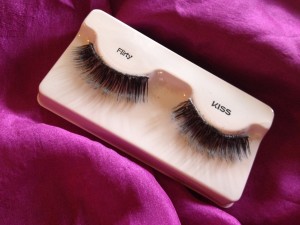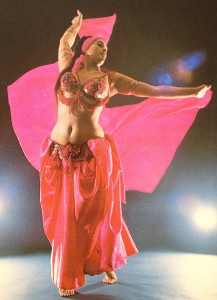
Yes, this week I’m writing about false eyelashes since they’re now the fashion amongst belly dancers. Back when I started, heavy mascara sufficed.
In the ’70s, my mother would painstakingly glue tiny clumps of false lashes to her own. I’d sit on the commode and watch her twease a clump, dip the end in stinky glue and move that mess toward her eyes. I couldn’t look away, but there was no way I was putting that crap on my own lashes.
Flash forward to my first belly dancing gig in over a decade and I’m in the bathroom with tweezers and glue that doesn’t stink and strip lashes I picked up at Walgreen’s and I’m realizing that I’m really glad my husband was a teen in the ’70s because I needed a consult to get the lashes on straight.
As I mentioned before, the things are heavy , like wearing hand weights on your eyelids. A number of gigs later, I can tell you that men get stupid when you where false eyelashes. Whether it’s my husband, his pals, the waiter pouring my drinks or the checkout guy at Rite Aid (pantyhose, not eyelashes — they’re suprisingly reusable) they all suck in their breath when I lift my eyelids high enough to see them. To a man, they act like little boys who’ve found an unexpected present under the tree. Unlike the influence of modern adornments, men keep a polite, but amazed, distance. For someone who’s dealt with sexual harrassment in the workplace and criticism from fellow feminists for wearing makeup and earrings it’s a tantalizing breath of power.
While I hesitate to break the false eyelash spell, I wonder what else the ’70s might have to teach me.
When I started belly dancing in the ’90s, much of the dancing was heavily Modern Egyptian, which wasn’t bad. It just wasn’t the image that made me want to belly dance. Except I didn’t think I had an image in my head.
Turns out that if you watched television in the 1970s, you watched a lot of belly dancing. Nearly every one of my family’s favorite shows included a belly dancer at some point.
Since that time, I’ve learned that there was a shift in America when dancers travelled to Egypt and came back to tell some gorgeously talented dancers that they were doing it “wrong” instead of understanding that what they were doing was different.
Many of the dancers in clubs across the United States tested their talents with musicians from a variety of countries, working to express Egytpian style for one audience, Turkish for another, Greek for a third or performing their own mix of styles that, by all rights drew on heavy Turkish influences.
This is where I want to dance, but sadly, these clubs no longer exist. But the music does and there are a number of dancers that graced those stages and dance floors, racking up hour after hour of experience that has transformed them into true masters of this art that I adore.
While many of these dancers are still teaching and performing, the audience that once loved them has shrunk to practioners of their dance form.
That’s not good enough.
The rest of you are missing out.
There are a whole bunch of people who don’t even know these dancers exist. Well, I’m going to change that. Starting with next week’s blog post.
Once a month, I’ll be interviewing a dancer from the ’70s or earlier and sharing video clips of performances as well as insight and anecdotes and how you can get in touch with them to take classes or watch them perform.
NEXT WEEK: Maria Morca

Next week I’ll be featuring my dance coach, Maria Morca. Maria’s racked up 61 years on the stage and can still make me sweat during our sessions. For dance historians out there, she studied with one of the mothers of modern dance, Ruth St. Denis.
UPDATE: Maria tells me that, despite labeling, Miss Ruth is only in the first clip presented in the video below.